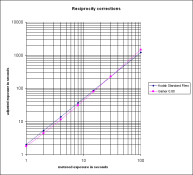Reciprocity failure as "expansion"
Here's my thinking on this, which jibes with other things I've read in the past, and which I _have not tested_ in the real world. It agrees in principle with the information from Covington and others that I've read, and in general with the adjusments in development suggested by Kodak and others. Ryuji Suzuki indicates increased contrast as well at:
http://silvergrain.org/Photo-Tech/reciprocity.html which is worthwhile reading if you're concerned about reciprocity failure. He specifically addresses the problem of increased contrast, and uses a polynomial expression for the Covington/Schwarzschild exponent, but doesn't say exactly what it is. If I'm reading it correctly, it might be a third order polynomial.
So here was my thought process:
Say you have a scene which has a medium gray and important detail at -2 stops and + 2 stops from the gray card (or incident reading). Without accounting for reciprocity they meter at 64 seconds, 16 seconds, and 4 seconds. With Ilford's recommended 0.51 film factor, that converts to 490 seconds, 61 seconds, and 8.8 seconds using the Gainer formula. The ratios are no longer 0.25/1/4, but become .125/1/6.95 after correction, so that an exposure at the corrected medium gray exposure of 61 seconds is underexposed below that point on the "tonal scale" and overexposed above it. In this instance, 2 stops under becomes 3 stops under and 2 stops over becomes 2.8 stops over. So in Zone system terms, Zone III has dropped to Zone II and Zone VII has risen almost a full stop to Zone VIII. This is caused by doing the exposure compensation for medium gray, which undercompensates for darker areas and overcompensates in lighter areas. So reciprocity itself is introducing a form of "expansion", and reduced development can, to some degree, be used to "contract" that expansion back into a printable range.
I have done a little spreadsheet that's does this calculation for me, and I can plug in a film factor and three different exposure times to see what happens to the range from -4 to + 5 stops from medium gray in 1 stop steps. It plots a little graph with a line for each of the exposure times, showing how the range of tones changes with extended exposures. Interestingly enough, if you plug in the numbers for TMAX and look at the results relative to the information posted here for development changes with extended exposures by Will S, you get a reasonable match.
These calculations use the medium gray exposure time for the reciprocity corrections using the Gainer formula, but other values away from medium gray could be used as well. The included chart allows you to view the effect on exposure areas at -4 to +5 stops from medium gray. The changes are calculated by adjusting the exposure for medium gray and comparing the required adjustments for other tones at 1 stop intervals, then taking the ratio between the adjustments required for other tones and the adjusted gray tone time. That ratio is converted to stops and plotted. The black "standard" line is the standard 1:2 ratio per stop to be used as a baseline for comparison. The attached chart uses TMX and the Gainer factor of 0.069 determined from the Bond article.
This is at least a place to start. I have a nagging feeling that I'm not completely taking care of the compounded effects with this method, so I have to give it some more thought. I'm posting it as a way to stimulate thoughts and comments, not as a final answer to the question.
Lee







